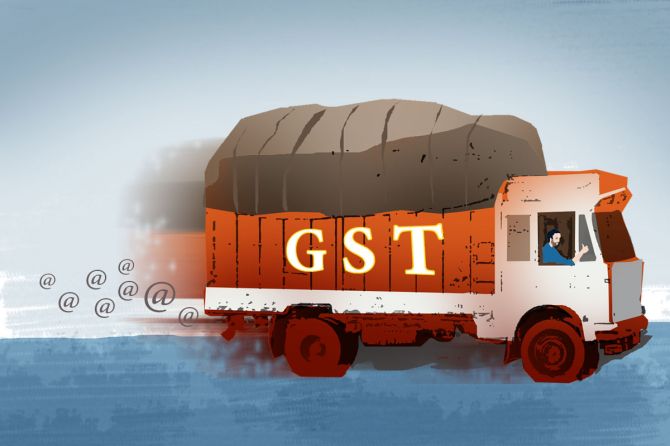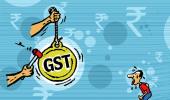Of the two rate structures on the table, one suggests tax slabs of 8 per cent, 16 per cent, and 24 per cent.
The other proposes tax slabs at 9 per cent, 18 per cent, and 27 per cent.

The fitment panel under the Goods and Services Tax Council is discussing two options to replace the current four-slab rate structure for making its proposal to a group of ministers (GoM) tasked with recommending changes towards GST rationalisation.
Both options seek to ensure that there is no adverse impact on the prices of essential goods for mass consumption.
Of the two rate structures on the table, one suggests tax slabs of 8 per cent, 16 per cent, and 24 per cent.
The other proposes tax slabs at 9 per cent, 18 per cent, and 27 per cent.
Both scenarios focus on shielding essential goods and may include a provision of tax abatements.
However, luxury goods -- often referred to as 'sin goods' -- may be subject to different treatment, according to preliminary discussions.
"Certain options have been discussed as part of the rate rejig exercise. However, nothing has been finalised yet. The final recommendation will be presented to the GoM for its perusal," an official with knowledge of the discussions told Business Standard.
The fitment panel, comprising revenue officials from both Centre and states, is responsible for assessing the revenue impact of rate rationalisation.
"The GoM has the discretion to consider these suggestions," the official noted.
This group, which now includes six state ministers, is expected to give due consideration to the fitment panel's suggestions in its final report to the GST Council.
Chaired by Finance Minister Nirmala Sitharaman, the influential GST Council is expected to meet between August 21 and August 23, during which it is likely to be apprised of the status report on rate rationalisation.
In her Budget speech on July 23, Sitharaman emphasised the necessity of GST rate rationalisation, highlighting its critical importance.
The GoM, recently reconstituted to reduce its membership from seven to six, leaving Goa out, is anticipated to convene its first meeting before the GST Council meeting.
The newly formed panel is chaired by Bihar's Deputy Chief Minister Samrat Chaudhary.
The panel also includes UP Finance Minister Suresh Khanna, Rajasthan Medical and Health Services Minister Gajendra Singh, West Bengal Finance Minister Chandrima Bhattacharya, Karnataka Revenue Minister Krishna Byre Gowda and Kerala Finance Minister K N Balagopal.
This financial year, the GST regime might undergo a transformation, transitioning from a four-slab structure to a three-slab one.
The current structure consists of standard rates of 5 per cent, 12 per cent, 18 per cent, and a top rate of 28 per cent.
'When we meet for the next GST Council meeting (in August), we will start a discussion on rate rationalisation. There will be a presentation by the GoM, irrespective of whether its report is a draft. And then the council will start the discussion on rate rationalisation, Finance Minister Sitharaman had said on June 22 meeting of the council.
The six-member GoM is charged with recommending necessary rate rationalisations and addressing the inverted duty structure to simplify the rate framework, review the GST exemption list, and bolster GST revenues.
First established in 2021, the state ministers' panel was reconstituted in November 2023 after its then head, Basavaraj S Bommai, suffered a debacle in the Karnataka assembly elections.
Another reorganisation ensued following the departure of then Bihar finance minister Vijay Kumar Chaudhary.
Previously, under the leadership of Karnataka's then finance minister and chief minister Bommai, the panel presented an interim report at the June 2022 GST Council meeting, requesting additional time for final recommendations.
Over 1,200 goods and services are subject to GST. Beyond the standard rates, the tax structure includes special rates of 0.25 per cent, 1.5 per cent, and 3 per cent.
Certain goods are exempt from tax. The bulk of GST revenue is derived from the 18 per cent slab, followed by the 28 per cent slab, which contributes 16 per cent to the total GST revenue, with the remainder coming from the 5 per cent and 12 per cent slabs.
Feature Presentation: Aslam Hunani/Rediff.com












 © 2025
© 2025